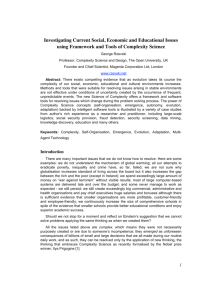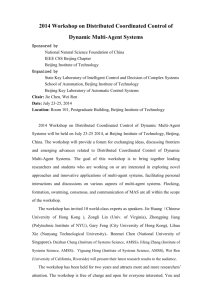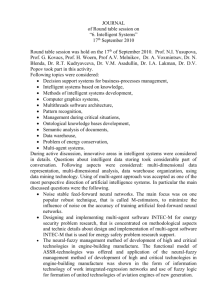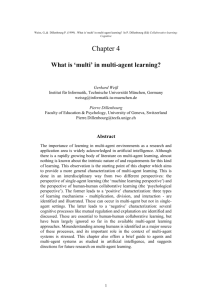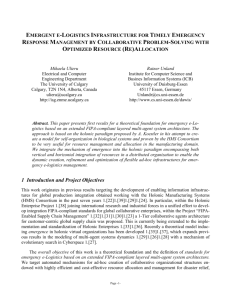Using Tools of Complexity Science to Diagnose the Current
advertisement
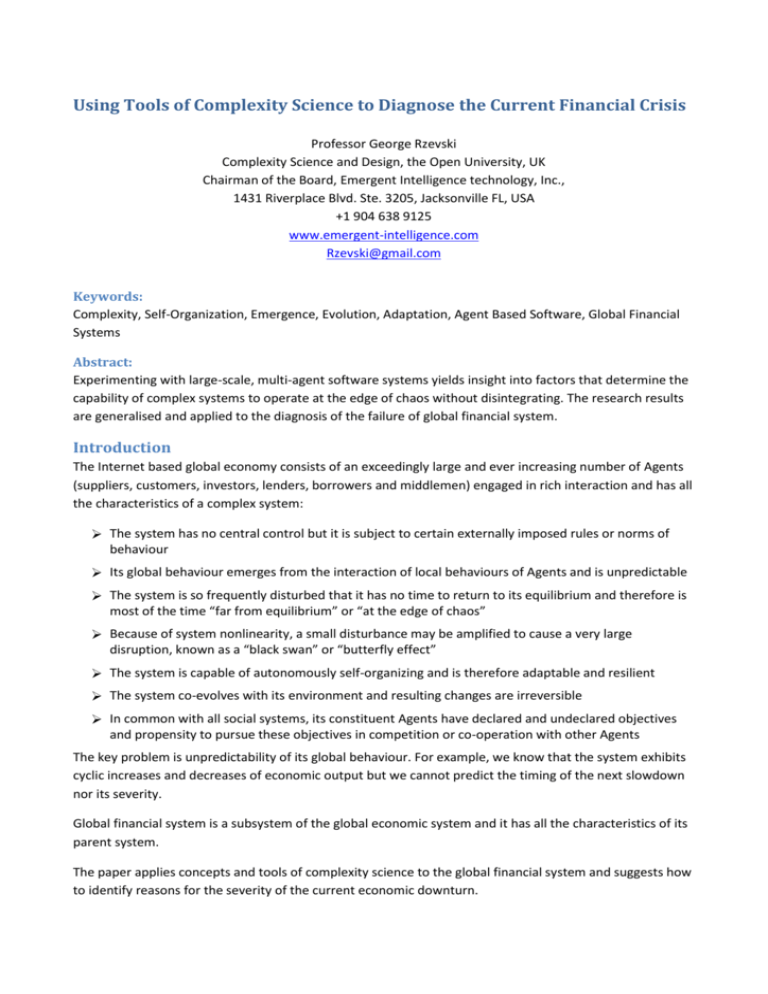
Using Tools of Complexity Science to Diagnose the Current Financial Crisis Professor George Rzevski Complexity Science and Design, the Open University, UK Chairman of the Board, Emergent Intelligence technology, Inc., 1431 Riverplace Blvd. Ste. 3205, Jacksonville FL, USA +1 904 638 9125 www.emergent-intelligence.com Rzevski@gmail.com Keywords: Complexity, Self-Organization, Emergence, Evolution, Adaptation, Agent Based Software, Global Financial Systems Abstract: Experimenting with large-scale, multi-agent software systems yields insight into factors that determine the capability of complex systems to operate at the edge of chaos without disintegrating. The research results are generalised and applied to the diagnosis of the failure of global financial system. Introduction The Internet based global economy consists of an exceedingly large and ever increasing number of Agents (suppliers, customers, investors, lenders, borrowers and middlemen) engaged in rich interaction and has all the characteristics of a complex system: The system has no central control but it is subject to certain externally imposed rules or norms of behaviour Its global behaviour emerges from the interaction of local behaviours of Agents and is unpredictable The system is so frequently disturbed that it has no time to return to its equilibrium and therefore is most of the time “far from equilibrium” or “at the edge of chaos” Because of system nonlinearity, a small disturbance may be amplified to cause a very large disruption, known as a “black swan” or “butterfly effect” The system is capable of autonomously self-organizing and is therefore adaptable and resilient The system co-evolves with its environment and resulting changes are irreversible In common with all social systems, its constituent Agents have declared and undeclared objectives and propensity to pursue these objectives in competition or co-operation with other Agents The key problem is unpredictability of its global behaviour. For example, we know that the system exhibits cyclic increases and decreases of economic output but we cannot predict the timing of the next slowdown nor its severity. Global financial system is a subsystem of the global economic system and it has all the characteristics of its parent system. The paper applies concepts and tools of complexity science to the global financial system and suggests how to identify reasons for the severity of the current economic downturn. It examines primarily the effects of structural factors of the global financial network on its global behaviour, taking into account features such as: (a) the speed of Agent interactions, (b) the number of links between Agents, (c) the adequacy of external rules of behaviour imposed upon Agent decision making processes, and (d) the adequacy of social representation in Agent negotiations. Method Research results reported in this paper have been achieved by monitoring and analysing behaviour of largescale complex software systems developed under the leadership of the author and his close collaborators for a number of business clients, which are now in commercial use, and extrapolating observed features to the global financial system. Therefore the results are tentative and it would be prudent to test them by extensive simulation experiments. Complex Systems Examples of Complex Systems include: global economy; a national economy; ecology; a swarm of bees; a human being; human society; culture; climate; road traffic; a swarm of software agents and life span of an aircraft or a car. Examples of complex systems where a capacity to rapidly self-organise provides substantial resilience to strong external attacks include: epidemics, human immune system, terrorist networks and the Internet. A common feature of all systems listed above is that they do not have a centralised control – their behaviour emerges as a result of the interaction among their components and between components and the environment. The decision making power of different Agents may vary, but as a rule, Agents have certain autonomy limited only by accepted or imposed norms of behaviour; they do not work under precise (algorithmic) instructions. The global behaviour of such a system is not possible to predict. Complexity versus Determinism There are two contrasting philosophical theses [1] about the Universe. The first thesis is that the world is based on the “grand design” and therefore its behaviour is predictable (deterministic). Any uncertainty is due to our inability to understand the world and to reduce uncertainty we have to discover laws of nature. Great philosophers and scientists subscribed to this worldview, including Aristotle, Kant, Newton and Einstein. The second thesis is that the world is inherently unpredictable (complex) because it evolves with time often due to autocatalytic and self-accelerating properties of some of its elements. Its evolution is irreversible and leads to an increase in complexity. As Prigogine wrote [1], [2], the future is not given; it is under perpetual construction. Supporters of this thesis include Buddha, Darwin, Popper and Prigogine. Whilst the notion of a deterministic world was very popular at the point in history when we witnessed great discoveries of Newtonian science, at present we seems to be overwhelmed by complexity of environments in which we live and work, and the dynamics of change is such that the maxim “you cannot enter into the same river twice” rings true. Under present circumstances the idea of a perpetually evolving world characterised by rich interaction of its constituent components seems very plausible [3]. Evolution Generates Complexity The interesting questions are where complexity comes from and why there are currently so many complex issues? There exists compelling evidence that as the evolution of our Universe takes its course, the ecological, social, political, cultural and economic environments within which we live and work increase in complexity. This process is irreversible and manifests itself in a higher diversity of emergent structures and activities and in an increased uncertainty of outcomes. Society co-evolves with technology for wealth creation. Industrial Society, where the key resource was Capital and majority of people were employed in industrial production of goods, superseded the Agricultural Society, in which the key resource was Land and majority of people were employed in agriculture. We have now entered a new transition from industrial to Information Society, the society in which the key resource is Knowledge and were majority of people are employed in knowledge-based services (information processing) rather than production of goods. The current transition towards Information Society is particularly notorious by its very steep increase in complexity caused by globalisation as enabled by (a) the rapid spread of the Internet across the globe, (b) a considerable increase in opportunities (and reduction of costs) for global travel and (c) concerted efforts at reducing tariffs and adopting instruments that facilitate the global exchange of goods and services. Agricultural Society Land DISTRIBUTION NETWORKS Local roads Industrial Society Capital Motorways & Railways National Information Society Knowledge The Internet Global KEY RESOURCE SCOPE Local Table 1. The complexity of markets increases with each transition Major Paradigm Shifts Created by the Transition to Information Society Emergence of Global Economy In the socio-economical sphere there is a very important shift from nation-centred industrial markets to the global economy, enabled by the abolition of tariffs and the rapid growth of the Internet. Global economy consists of a vast number of suppliers and customers rapidly matching supplies to demands and then, as rapidly, changing previously agreed matches as soon as better opportunities present themselves, each agent trying to increase their gain. The global market has all characteristics of a very complex system [4]. The overall distribution of resources to demands emerges from individual transactions. Globalisation increases wealth across the board (there is a saying among economists “globalisation tide lifts all boats”). According to recent statistics during the last 30 years the world as a whole has enjoyed an unprecedented economic growth, with one downside feature - the gap between rich and poor has increased in all countries except Ireland. The ever increasing numbers of players in the global market and the speed of information flow over the Internet accelerated market dynamics to such as an extend that the current generation of data-driven information systems supporting business processes will not be able to cope for long. Let us illustrate this statement by describing problems experienced by global consumer product supply chains consisting of a large number of suppliers, warehouses, logistics operators, assembly plants and retailers distributed around the world, encompassing together a vast quantity of resources such as machine-tools, robots, conveyers, loading bays, trucks, freight trains, cargo planes and cargo ships, operated by hundreds of crew members, loaders, operators, progress chasers and supervisors. Such supply chains are rendered unmanageable by the current generation of enterprise resource planning systems, schedulers and optimisers because of the frequent and unpredictable occurrence of events such as the arrival of new orders, order cancellations, changes in previously agreed orders and delivery arrangements, delays, failures of logistics resources and human errors. The key problem is that the frequency of market driven changes is typically 1-2 hours whilst the time required to re-schedule a plant is not less than 8-10 hours; in global logistics, once a pallet is assigned to a pipeline its destination cannot be altered until it emerges from the other end of the pipeline, which may take several days. We have to accept that complexity is a norm and that attempts to simplify complex situations, which was a useful managerial and technological philosophy in industrial society, when complexity of markets was much smaller, is now harmful. Complexity of markets has to be exploited - it offers rich opportunities for those who master the mindset, skills and tools of adaptation and resilience. Transition from Manufacturing to Knowledge-Based Services The shift of manufacturing from the developed to developing countries is a part and parcel of globalisation. The replacement of manufacturing by knowledge-based services as the main wealth creating activity may be achieved only in countries where there exists advanced IT and a large number of high-class knowledge workers: researchers, designers and decision makers in financial services, IT, engineering, consulting, media, construction, architecture, entertainment, etc. The early adoption of knowledge-based services provides an excellent opportunity for economic prosperity at the time when manufacturing-focussed countries face stiff competition. The limitation is that advanced knowledge-based services require systems capable of knowledge discovery and repository in a format suitable for the easy retrieval and application. Current IT was not designed for such applications. Emergence of the Digital Leisure Industry and Social Websites The current shift from paper-based and analogue media to digitally-enabled entertainment as the main leisure activity was made possible by the astonishing progress in designing miniature and powerful processors and memory chips, and appropriate communication and application software, as evidenced by the rapid spread of multi-channel digital TV, digital cameras, cellular phones and digital audio and video devices. This is complemented by a rapid growth of websites for downloading and uploading art, music and multimedia products. Apple iPod and iTunes together with YouTube and My Gallery are the icons of this revolution. The spread of the so called “social websites” where individuals display their creative products to be perused by global audiences is particularly significant and almost certain to continue well into the second half of this century. The shift from corporate media to the internet-based media has many unexpected implications, not least the “long tail” [5], “the wisdom of crowds” [6] and “economy of attention” [7] phenomena. Personal Globalization Trough the specialised websites it is now possible to outsource many personal tasks such as: search for dating partners, personal secretarial tasks, personal website design, bookkeeping for freelancers, private maths coaching for pupils, and graphic design for weddings. The outsourcing provides opportunities to take advantage of better value for money, e.g., services of a college graduate in India for $15 per hour (versus $60 per hour in the USA), maths coaching from Bangalore for $99 per month or graphic design from Argentina for a wedding at $65 per job; but also, to reduce inequality of knowledge workers around the globe by providing freelance work for those in developing countries. Supercrunching As available computer storage space is increasing relentlessly and the Internet enables sharing of data, there is a trend to improve intuitive judgements of experts with extensive data mining aimed at discovering useful patterns in data, which amounts to using computers to discover Knowledge, the key resource of Information Society. The Supercrunching is used extensively in marketing to individual consumers but also in unexpected areas, which include: football coaching, medical diagnosis and in teaching – discovering which teaching methods work with which individual student. Threats from New Forms of Violence As globalisation takes its course with the rapid increase in the number of people connected to the Internet and/or travelling across the globe, new global complex systems have emerged, such as, terrorist networks, epidemics, massive hacking attacks, phishing and spamming. Ineffectiveness of Very Large Systems Under currently prevailing conditions of perpetual change very large systems appear to be too rigid and unable to adapt to rapid changes in their environments. Examples from the UK are many and include: Super-size comprehensive schools with 1,500 to 2,000 pupils have the worst record of bad behaviour in the classroom and limited academic achievements (source: the charity Human Scale Education). In contrast, smaller schools provide a student-friendly pedagogical environment and consequently good academic results. Very large private companies as a rule generate less profit than small-to-medium size enterprises. Exceedingly large computer systems, including National Health Service System, Ambulance Management System, Air Traffic Control System, Inland Revenue System and Drivers Licence System are too often delivered late, over the budget and, in some cases, never achieved expected performance. In contrast to difficulties experienced by large airline companies, a new generation of small and highly efficient jet aircraft, with 3 to 4 seats only, are starting a revolution in aviation by prompting a large number of start-ups promising to offer regional air taxi services. The Prospect of Semantic Web The next technological revolution will be the shift from the current data-driven Internet to the new Semantic Web and it is likely to be dramatic, as the new generation of systems will be enabled to “understand” the meaning of data. Semantic Web is an old dream of computer science researchers, which is now firmly on the way to be realised with first programs based on ontology and multi-agent software being released and tested in commercial applications. Further progress is ensured by the concentrated effort of a large number of researchers in EU and USA. Functionality required to implement Semantic Web is fundamentally different from that offered by the current software technology. Clarifying semantics of sentences expressed in a natural language requires intelligent computational effort rather than brute force of current software. All successful current Semantic Web prototypes are based on ontology and multi-agent technology. Cloud Computing Information technology inexorably moves towards the full global interconnection of all digital processing devices and all digitised information content – towards the CLOUD. There is a trend to store data on servers located on big “server farms”, distributed around the globe and well protected, and to access it from any point in the world where the users may happen to find themselves. Our information-processing world is growing rapidly, its capacity doubling approximately every two years. In 2008 it was characterised by: 100 billions clicks per day; 4 billion digital devices (such as computers, telephones, RFIDs, etc) connected to the internet (in excess of the number of neurones in a human brain); 55 trillions links between web pages (similar to the number of synapses in a human brain); 2 million emails per second; 8 terabytes of traffic per second; 65 billion phone calls per year; 600 billion RFID tags in use. It is estimated that by 2030 all computers, personal organisers, telephones, iPods, TVs, DVD players, modems, radios, film projectors, video players, hi-fi decks, including all their content, i.e., alphanumerical data, texts, films, videos, broadcasts, podcasts, newspapers, books, music, emails, blogs, websites and magazines, will be linked forming one Global Network - the Cloud. Moreover, a great many natural and designed objects on the planet (livestock, aircraft, trains, vehicles, appliances and machines of all kinds) will be linked by means of RFID tags to the, so-called, The Internet of Things, which will be, naturally, a part of the Cloud. And so will most people through the medium of Smart Cards and, at some stage, through Smart Clothing, Smart Watches, etc. The idea of Cloud Computing is to have a total interconnectivity of all information creators, processors and consumers. At the current state of development there are many smaller Clouds, including those operated by Google, Apple, IBM, Microsoft, etc. These Clouds will be gradually linked into the interconnected Global Cloud. Black Swans An inherent dangerous characteristic of all complex systems is their high nonlinearity, which may turn small disturbances into catastrophic outcomes, named Black Swans [8]. The most dramatic example of a Black Swan was the recent tsunami. As complexity of the internet-based global economy increases, we can expect from time to time the occurrence of unforeseen cataclysmic events affecting global economy, as exemplified by the current collapse of the global financial system. This is a downside of complexity and we can do very little about Black Swan causes. What we can do is to design information networks in a way, which minimises propagation and acceleration of instability through the networks, and to design our sociotechnical systems to be adaptable and resilient. More on this topic later. Using Complexity Science Concepts and Tools to Resolve Complex Issues The Thesis Complex situations can be effectively investigated only by using models that are of similar complexity as situations that are being modelled. Leaving aside for the moment the definition of “similar”, the following argument supports this thesis complex situations change during the modelling process and therefore their models must be capable to adapt to these changes; the adaptation must be autonomous (without waiting for instructions from the modeller) which is only possible if models have capabilities of self-organisation and intelligence. In other words, Models must be able to co-evolve with situations that they model. The key implication of this thesis is that conventional computer programs cannot be used as models for complex situations because they are not adaptable. They cannot change by themselves - they must be instructed to do so by programmers. At present, only multi-agent software technology can support adaptation. Two Types of Complex Situations Complexity of certain unresolved critical issues (such as global warming, poverty and population growth) is so high that we can expect, at best, to build much-simplified models of these issues with a view to gaining some insight into their resilience to our attempts to resolve them. Let us refer to such issues as Exceedingly Complex. An example of a brilliant work on modelling of exceedingly complex systems is a study of global population growth by Kapitsa [9]. In contrast, there are many complex issues where constituent components and their interactions can be identified and modelled by constructing a Virtual World (a model) almost as complex as the Real World that is being modelled. Nearly all complex business situations, as well as many complex social, economic, security and technological problems, as well as the evolution of urban systems, fall into this category [10], [11], [12]. I shall refer to such issues simply as Complex. The Art of Modelling Complex Situations The effective modelling consists of several stages: 1. Collecting and organising domain knowledge - The first step is to collect and organise knowledge on the domain of the real world that is being investigated. The most effective method of representing knowledge on a complex domain is to construct a network in which nodes are domain Concepts and links are Relations between Concepts. For example, for a supply chain relevant Concepts include: Order, Supplier, Warehouse, Truck, Cargo, Road and Route. Each Concept is characterised by attributes and rules constraining its behaviour. Such domain knowledge representation is called Ontology [13]. 2. Constructing a Virtual World - The next step is to build a Virtual World consisting of instances of Concepts and their Relations from domain Ontology. For a supply chain, a Virtual World will be a network in which nodes are Order O1, Order O2, … Supplier S1, Supplier S2, … Cargo C1, Cargo C2, … Truck T1, etc, and links are “S1 supplies O1”, “C1 is loaded on T2”, etc. Complex systems, such as supply chains of large international organisations, and Virtual Worlds that represent them, may contain millions of objects, attributes, rules and relations. To construct Virtual Worlds for such complex problems one requires powerful multi-agent software tools [14]. 3. Connecting Virtual World to the Real World - The Real World (i.e., a complex situation that is being modelled) is perpetually changing. The changes are represented by the occurrence of unpredictable events exemplified, in a supply chain, by: Arrival of an Order, Order Modification, Order Cancellation, Road Closure, Track Failure, etc. The occurrence of every Real Event must be communicated instantly to the Virtual World where an equivalent Virtual Event is created, causing the affected part of the Virtual World to adapt to changes originated in the Real World. Every change (adaptation) of the Virtual World must be communicated to the Real World before the occurrence of the next Real Event [15]. 4. Empowering Virtual World to manage the Real World in real time - An Agent (a small computer program) is assigned to every node of the Virtual World with responsibility to maintain its integrity. For example, if a loaded Virtual Truck breaks down, the Truck Agent sends messages to Agents of all affected nodes letting them know that this Virtual Truck does not exists any more. The message provokes a flurry of activities among affected Agents who try to accommodate the failure by searching for a replacement. As soon as a solution is found, it is conveyed to the Real World for implementation, ensuring that the two worlds co-evolve (change in unison). 5. Investigating behaviours of the Real World by experimenting in the Virtual World - Once a suitable Virtual World is constructed in software, it could be used to simulate behaviours of the Real World under different states of its environment, e.g., studying behaviour of a supply chain under varying market conditions. Examples of Solved Practical Complex Problems The author and his team have designed a large number of agent-based software systems for investigating or managing large-scale complex situations, many of which have been implemented and are in regular use. Examples are described in detail in a series of papers and they include: Real-time scheduling of car rentals across Europe for one of the largest rent-a-car companies in the world [15] Real-time scheduling of over 2,000 taxis in London [16] Real-time scheduling of a fleet of very large tankers (10% of the world total capacity) transporting crude oil around the globe [17] Real-time production scheduling [18] Dynamic pattern discovery for a leading insurance company [19] Semantic analysis and search for a genetic research organization [20] Simulation of virtual enterprises [21]. The scale of the solved problems and the commercial success of developed systems have attracted attention of European Complexity Science Community, which singled out the author’s work as a success case in applied Complexity Science. Can we Learn from Complexity Science how to Avoid Financial Crises? The answer is a tentative YES. Financial networks are, after all, complex systems and therefore lessons learned during designing artificial complex systems, such as large-scale real-time multi-agent schedulers, should be applicable. The key lesson learned from ten years of experience in constructing solutions to large-scale complex problems is that however carefully you design a complex system, it will not immediately work as expected. This is a rule, rather than an exception, because the overall behaviour of such systems emerges from the interaction of constituent Agents and is, in principle, not predictable. However it is always possible to tune the behaviour of the designed system by adjusting critical system parameters. The issue we want to avoid is the propagation of oscillations through the system, which causes instability and may result in system disintegration. The result of successful tuning of the system is that its behaviour, although unpredictable in detail, never leaves the specified region of the behaviour space, and recovers speedily after each disturbance. Main parameters that need tuning are: 1. The degree of autonomy given to Agents 2. The weight given to the Enterprise Agent 3. The speed of transactions between Agents 4. The degree of interconnectivity among Agents Let us consider the importance of each above parameter in turn. The degree of autonomy of Agents is perhaps the most important factor that determines the behaviour of a complex system. If Agents are severely constrained, the complexity is lost and with it the adaptability and resilience of the system. The software behaves exactly as a conventional computer program - it is deterministic - and if a situation is encountered that was not foreseen by the programmer, the program stalls. If, on the other hand, Agents are given too much freedom, the complexity increases and the system behaves erratically. To the best of author’s knowledge there is no theory that is capable of prescribing the correct degree of freedom. Even more importantly, it appears that rules governing Agents need to be tighten up or relaxed depending on the dynamics of the situation. In the presence of extreme events it seems to be advantageous to give to Agent a greater freedom to rapidly find an effective way to adapt, whilst when the environment is less turbulent, it may be more appropriate to limit the risk of uncontrolled innovation. Complexity is, by definition, present in situations where autonomous component interact in unpredictable manner. When agent-based software is used for modelling of complex situations, software Agents are assigned to each autonomous component with a view to exchanging messages among themselves and thus simulating component interactions. The author’s experience shows that it is always advisable to introduce an additional software Agent to represent the situation as a whole. The author has named this Agent as the Enterprise Agent. Its role is to ensure that the no Component Agent gains an advantage for itself on expense of the system as a whole. It is important to underlie that Enterprise Agent does not issue instructions to Component Agents; it is rather an equal partner in negotiations. Whenever a new event occurs that disturbs the current state of the system, it takes a certain period of time for the system to adapt to the new situation and for Agent negotiations aimed at achieving adaptation to settle. The excessive speed of transactions among Agents may lead to instability because it may cause the initiation of a new wave of Agent negotiations before the previous one had settled. On the other hand, a too slow speed may prevent the system to adapt to a disturbance in time before the next disturbance occurs. A skilful tuning of the transaction speed is required. In a large network in which all nodes are connected to each other the interactions among nodes are completely unpredictable and often lead to extreme events - Black Swans. Reducing severely the interconnections limits the adaptability of the network. The best practical solution is to partition networks into regions with densely interlinked nodes within each region, and to interconnect regions sparsely. A proper partitioning limits the frequency of occurrence and intensity of extreme events. As experience in tuning complex systems accumulated, it became possible to compile rules for managing complexity, which are articulated below. Consistent application of these rules during early stages of design reduces a need for tuning. Rules for Managing Complexity Let me reiterate that any attempt to simplify a complex problem, which is not fully under our control (such as global worming, or dynamics of the global market), is counter productive. The solution we obtain is a solution to a simplified, rather than to the original, complex problem. However, if we are in a position to design from scratch, or to modify key parameters of a complex system (such as a multi-agent software or a global digital network linking financial institutions), there is a lot we can do to ensure its stability. Key design rules, derived from discussions above, are quite straightforward: Construct network ontology incorporating rules that regulate, but do not curtail autonomy of Agents; continuously review the effectiveness of rules and modify them when required. Appoint Enterprise Agents to represent global community interests in Agent negotiations. Partition the network into regions (which may be logical rather than geographical) and limit the number of links and speed of information transfer between regions. Limit the speed of transactions among Agents. Fig. 1 Partitioning a network into regions Let us apply these rules to an analysis of current highly interconnected digital network, which links financial institutions around the glob. Conclusion: Designing Stable Global Financial Systems According to analysis presented in this paper the current global financial network has the following systemic faults: Regulations imposed upon financial institutions are not flexible - the degree of freedom given to bankers to innovate was excessive under conditions of stability and insufficient under conditions of the crisis. The excessive speed of financial transactions and excessive interconnectivity of financial institutions increased the risk of instability and may have contributed to the occurrence of extreme events. The solution may include: Partitioning of the sector in a number of logical or geographical regions to limit the risk of the propagation of extreme events throughout the whole global system. Developing Financial Services Ontology for each region, incorporating the best available expertise on banking, investments, financial trading and regional peculiarities. Constructing a set of multi-agent simulators, perpetually evaluating the performance of regional and total financial systems. Instituting intelligent regulations, possibly different for different regions, based on a continuous evaluation of system performance. As stated at the beginning of this paper, these conclusions are derived by analogy rather than by direct investigation of the financial system and are therefore tentative. However, a study of the global financial system from the standpoint of Complexity Science would most probably yield similar results. Acknowledgement This research was only possible because of the most valuable contribution of Dr Petr Skobelev, who was in charge of a talented Russian software team that has developed large-scale intelligent systems used in research experiments. References 1. Prigogine, Ilya, “The End of Certainty: Time, Chaos and the new Laws of Nature”. Free Press, 1997. 2. Prigogine, Ilya, “Is Future Given?” World Scientific Publishing Co., 2003. 3. Holland, John, “Emergence: from Chaos to Order”. Oxford University Press, 1998. 4. Beinhocker, Eric, “The Origin of Wealth: Evolution, Complexity and the Radical Remaking of Economics”. Random House Business Books, 2007. 5. Anderson, Chris, "The Long Tail: How Endless Choice Is Creating Unlimited Demand", 2006. 6. Surowiecki, James, “The Wisdom of Crowds”. Abacus, 2004 7. Lanham, Richard, “The Economic of Attention”. The University of Chicago Press, 2007. 8. Taleb, Nassim Nicholas, “The Black Swan: The Impact of the Highly Improbable”. Penguin Books, 2007. 9. Kapitsa, Sergey, “Global Population Blow-Up and After: The Demographic Revolution and Information Society”. Report to the Club of Rome, 2006. 10. Rzevski, G., “Investigating Current Social, Economic and Educational Issues using Framework and Tools of Complexity Science”. Journal of the World University Forum, Volume 1, Number 2, 2008. 11. Rzevski, G., Skobelev, P., “Emergent Intelligence in Large Scale Multi-Agent Systems”. International Journal of Education and Information Technology, Issue 2, Volume 1, 2007, pp 64-71. 12. Rzevski, G. “A New Direction of Research into Artificial Intelligence”, Invited Paper, The Annual Conference of Sri Lankan Association for Artificial Intelligence, Colombo, 2008. 13. Rzevski, George, “Ontology and Relativity”. Volga Conference on Complex Adaptive Systems, Samara, Russia, 2005. 14. Rzevski, George, Skobelev, Petr, Andreev, V. “MagentaToolkit: A Set of Multi-Agent Tools for Developing Adaptive Real-Time Applications”. In Marik, V., Vyatkin, V., Colombo, A. W. (eds.) Holonic and Multi-Agent Systems for Manufacturing. Third International Conference on Industrial Applications of Holonic and Multi-Agent Systems, HoloMAS 2007, Regensburg, Germany, September 2007, pp 303-314. Springer LNAI 4659. 15. S. Andreev, G. Rzevski, P. Shveikin, P. Skobelev, I. Yankov, “Multi-Agent Scheduler for Rent-a-car companies”, Proc. of 8th Int. Conf. on Autonomous Agents and Multiagent Systems (AAMAS 2009), Decker, Sichman, Sierra, and Castelfranchi (eds.), May, 10–15, 2009, Budapest, Hungary. 16. Glaschenko, A., Ivaschenko, A., Rzevski, G., Skobelev, P. “Multi-Agent Real Time Scheduling System for Taxi Companies”. Proc. of 8th Int. Conf. on Autonomous Agents and Multiagent Systems (AAMAS 2009), Decker, Sichman, Sierra, and Castelfranchi (eds.), May, 10–15, 2009, Budapest, Hungary. 14. Glaschenko, A., Ivaschenko, A., Rzevski, G., Skobelev, P. “Multi-Agent Real Time Scheduling System for Taxi Companies”. Proc. of 8th Int. Conf. on Autonomous Agents and Multiagent Systems (AAMAS 2009), Decker, Sichman, Sierra, and Castelfranchi (eds.), May, 10–15, 2009, Budapest, Hungary. 17. Rzevski, George, Himoff, Jonathan, Skobelev, Petr, “Magenta Technology: A Family of Multi-Agent Intelligent Schedulers”. Workshop on Software Agents in Information Systems and Industrial Applications (SAISIA). Fraunhofer IITB. February 2006. 18. Andreev, M., Rzevski, G., Skobelev, P., Shveykin, P., Tsarev, A., Tugashev, A. “Adaptive Planning for Supply Chain Networks”. In Marik, V., Vyatkin, V., Colombo, A. W. (eds.) Holonic and Multi-Agent Systems for Manufacturing. Third International Conference on Industrial Applications of Holonic and Multi-Agent Systems, HoloMAS 2007, Regensburg, Germany, September 2007, pp 215-225. Springer LNAI 4659. 19. Rzevski, George, Skobelev, Peter, Minakov, Igor and Volman, Semen, “Dynamic Pattern Discovery using Multi-Agent Technology”. Proceedings of the MATH, SIP, TELE-INFO Conferences in Dallas, March 2007. 20. Rzevski, George, Skobelev, Peter, “Agent Based Semantic Web”, Semantic Universe Website, 2009. 21. Rzevski, George, Skobelev, Petr, Batishchev, Sergey and Orlov, A.: “A Framework for Multi-Agent Modelling of Virtual Organisations”. In Camarinha-Matos, L M and Afsarmanesh, H (eds), Processes and foundations for Virtual Organisations, Kluwer Academic Publishers, 2003, pp. 253-260.
